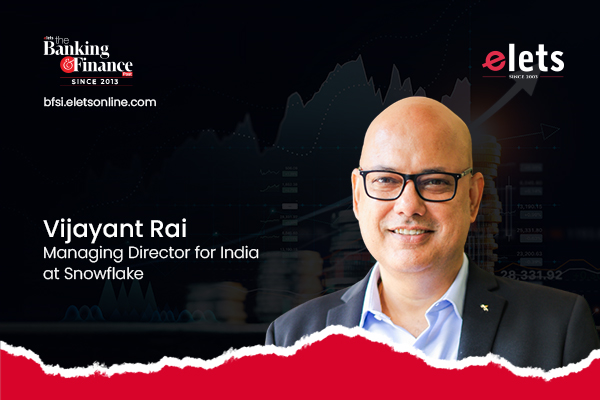India is undergoing a massive data-driven transformation, especially in financial services. It is driven by both technology and progressive policies. With digital public goods like Aadhaar and the India Stack, the country has achieved digital inclusion at an unprecedented scale, shared Vijayant Rai, Managing Director for India at Snowflake in an exclusive interaction with Vishwas Sinha of Elets News Network (ENN). Edited excerpts:
Q1: As India is transforming into a data-driven economy, what opportunities and challenges do BFSI companies face, and how can they navigate them effectively?
Over the past decade, India has undergone a massive transformation in how technology drives the economy, especially in the BFSI sector. This change is not just limited to finance but extends to digital public goods like Aadhaar and the India Stack, creating a data-driven country at a scale that’s unprecedented globally.
The BFSI sector has consistently been a first mover in adopting technology and innovation. Policy-supported innovations like digital public goods have been pivotal in accelerating financial inclusion. A prime example is UPI, which has given birth to numerous fintech startups and unicorns, reshaping the financial ecosystem.
With emerging technologies like AI becoming more prominent, financial institutions are rapidly adopting these for both external customer experiences and internal operational efficiencies. Organisations such as Bajaj Allianz General Insurance are already using platforms like Snowflake to drive their data transformation journey, focusing on customer 360 solutions and enhancing employee experiences.
As new technologies continue to emerge, the BFSI sector will remain at the forefront of innovation, leveraging data, AI, and scalable platforms to improve customer experience, drive operational efficiency, and transform the financial services landscape.
Q2: How do you view the impact of regulations like the Digital Personal Data Protection (DPDP) Act on how BFSI firms manage and secure data?
As India’s digital economy scales rapidly, regulations like the Digital Personal Data Protection (DPDP) Act have become essential in ensuring trust and accountability. In a high-volume digital environment (especially with platforms like UPI) regulations serve as critical guardrails to protect consumers while enabling innovation.
In the BFSI sector, regulatory frameworks from bodies like RBI, SEBI, and IRDAI help define clear compliance standards. At the same time, technology platforms are playing a key role in helping financial institutions meet these standards efficiently. Tools like data masking, access governance, and PII protection ensure sensitive data is handled securely and responsibly.
Also Read | Harnessing Growth In India’s Evolving Insurance Landscape
Rather than viewing regulations as roadblocks, the industry now sees them as enablers of innovation, laying the foundation for a safe, transparent, and scalable digital ecosystem. With the right tech infrastructure, firms can comply with evolving laws while accelerating digital transformation.
Q3: You said banks can use AI in seconds and apps in minutes. How does Snowflake enable this speed, and what impact does this have on BFSI companies?
Across industries, BFSI, manufacturing, retail, services, and digital-native companies. Many organisations are increasingly relying on fully managed, SaaS-based AI data cloud platforms to stay competitive. Therefore Snowflake plays a very crucial role, by providing a unified platform for securely hosting and managing vast volumes of data.
One of the biggest challenges legacy enterprises face is data silos. Where HR, sales, and operations data reside in separate systems and cannot communicate. Snowflake addresses this by breaking down these silos, allowing organisations to consolidate all their data in one place and unlock valuable insights through advanced analytics.
Beyond unification, the platform enables smooth collaboration across ecosystems. For example, a manufacturing company can securely share real-time data with its supply chain partners, enhancing transparency and operational efficiency.
Additionally, organisations can enrich their data by integrating third-party datasets—from financial intelligence sources like FactSet or LSEG—to develop smarter, more tailored products. This three-tiered approach—breaking data silos, enabling collaboration, and enriching datasets, is turning data into a strategic asset that drives innovation, customer value, and revenue growth.
Q.4 You have mentioned Bajaj Allianz earlier—could you give a few more real-world examples of how your clients are using Snowflake across different industries?
Snowflake works with a diverse and expansive clientele across industries, both in India and globally, including some of the most innovative and high-scale organisations.
In the BFSI and fintech space, Razorpay, which is a leading payment aggregator in India, is a prime example. They process massive volumes of transactions and serve over 100,000 e-commerce partners. Using Snowflake’s native data-sharing capabilities, they’ve built a product called DataSync to share real-time transactional data with their partners for fraud detection, reconciliation, and more. This helps in cutting down the complexity of traditional ETL processes.
Another standout use case is Chalo, a mobility tech startup operating in over 60 Indian cities. Using Snowflake, Chalo provides real-time insights for public bus arrivals and digital ticketing, improving daily commutes for millions. Similarly, Swiggy relies on Snowflake to manage dynamic logistics and optimize driver routing in real time, handling data from 70–80 million customers across India.
Beyond these, Snowflake supports manufacturing firms in integrating vast SAP datasets for better decision-making and operational efficiency. Globally, Snowflake powers data operations for over 750 of the world’s largest enterprises, enabling innovation and agility at scale across multiple industry verticals.
Q.5 Many BFSI organizations struggle with data silos and governance issues. How is Snowflake helps customers unify their data ecosystems while ensuring compliance?
Many public sector banks in India are over 100 years old and have accumulated fragmented systems over time—core banking, branch-level software, CRMs, and more—leading to massive data silos. These silos create operational challenges, like being unable to print simple customer statements due to “too many transactions.”
Snowflake is actively working with such legacy banks to break down these silos and modernize data infrastructure. By unifying data on a single cloud-native platform, we enable real-time access and improved customer experiences—like generating on-demand statements, detecting fraud patterns, or simplifying reconciliation.
Also, the rise of AI and LLMs is accelerating transformation. What used to be a multi-year journey is now happening faster with generative AI. For example, one of the leading Insurance firms is using Snowflake’s Cortex AI to extract fraud patterns and analyze millions of unstructured data (like PDF documents), simply using natural English queries.
These innovations, which once required multi-year transformation journeys, are now being fast-tracked thanks to generative AI combined with Snowflake’s secure and scalable architecture. From simplifying internal operations to transforming customer-facing services, Snowflake is enabling banks and insurers to truly modernize, one data problem at a time.
Q.6 How do you see enterprise data management evolving in the next 3–5 years, particularly with the rise of AI-driven analytics?
As digital adoption increases across industries, data volumes are exploding—making effective data management more important than ever. Enterprises today are focused on simplifying how they handle data, with a strong emphasis on interoperability. This means enabling data to flow freely between systems without being locked into a single vendor or format. Open table formats and scalable infrastructure are helping organizations manage growing data estates without compromising on flexibility or performance.
At the same time, AI is becoming central to extracting value from this data. Whether it’s structured or unstructured, organizations are investing in tools that can generate actionable insights quickly. Technologies like large language models (LLMs) are enabling new ways to interact with data—through natural language queries, automation of repetitive tasks, and digital assistants that support everything from customer service to internal analytics. These innovations are no longer futuristic; they are already being deployed to improve productivity and decision-making across sectors.
Generative AI, in particular, is accelerating transformation across industries like BFSI, healthcare, and agriculture. Tasks that once took years of IT development can now be fast-tracked, thanks to AI-powered automation. For instance, fraud detection, document processing, and real-time risk assessments are now possible at scale. This shift is expected to drive large-scale job transformations—India alone is projected to see around 38 million jobs evolve by 2030 due to AI-led productivity gains.
As the global population grows past 8.5 billion, solving large-scale challenges like food security, public health, and urban planning will require smarter, data-driven solutions. For a country like India, with its fast-growing digital economy and transaction-heavy sectors, AI and interoperable data platforms are not just enablers, but necessities for sustainable growth and inclusive innovation.
Q.7 Can you share any exclusive insights about how India’s financial sector is transforming, especially with the rise of fintech and digital public infrastructure?
India’s financial sector is playing a foundational role in the country’s transformation from a developing to a developed economy. One of the most impactful changes we’re witnessing is the rapid progress in financial inclusion. With the help of the government’s digital public goods infrastructure, like the India Stack, UPI, and the Account Aggregator framework, millions of people who were previously outside the formal banking system are now being brought into the fold. All of this is happening through something as simple and accessible as a mobile phone, which highlights the power of technology in enabling inclusive growth.
Also Read | Why MSME Growth in India Needs Bold Execution?
Moreover, the ecosystem itself is evolving rapidly. Alongside traditional banks, insurance companies, and NBFCs, we’re seeing a surge in fintech startups across India, especially in regions like Karnataka, Mumbai, and Delhi. These fintechs are leveraging data and AI to offer innovative solutions, streamline financial services, and cater to India’s massive, diverse population. Going forward, it’s clear that India’s path to becoming a digitally empowered economy will be driven by advancements in financial services, data infrastructure, and artificial intelligence.
Elets The Banking and Finance Post Magazine has carved out a niche for itself in the crowded market with exclusive & unique content. Get in-depth insights on trend-setting innovations & transformation in the BFSI sector. Best offers for Print + Digital issues! Subscribe here➔ www.eletsonline.com/subscription/



















